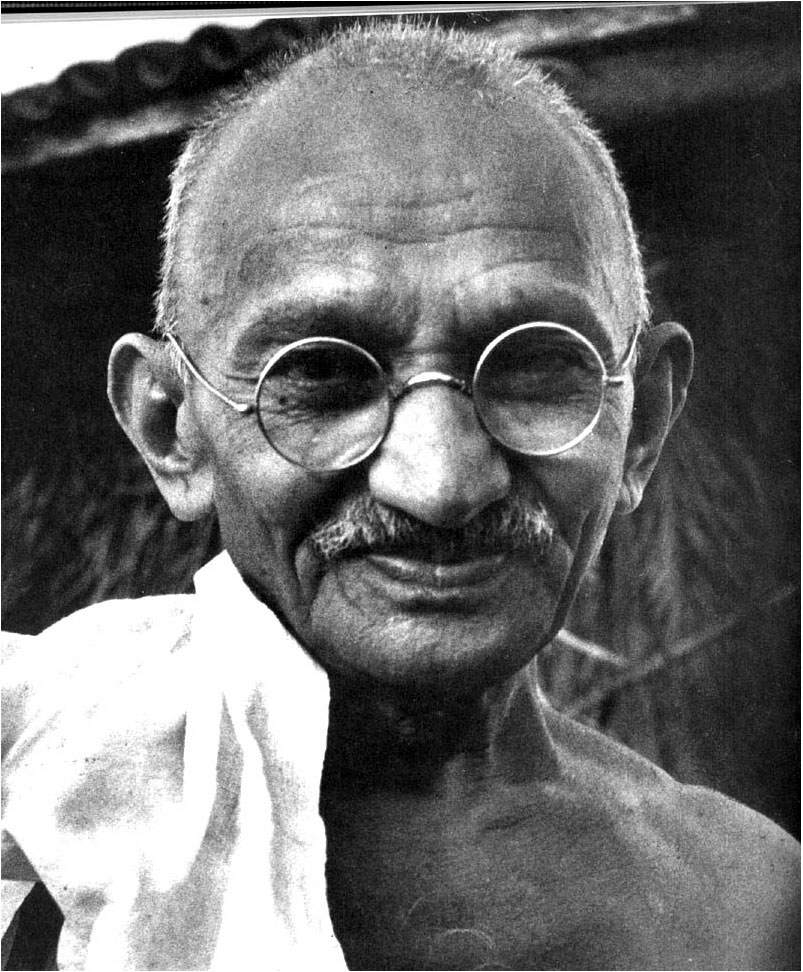Gandhi’s Art: Using Non-Violence to Transform “Evil”
by William J. Jackson
Gandhi c. 1945; photographer unknown;
a public domain image,
courtesy of Wikimedia Commons
“Changing the world begins with changing yourself; you have to become the change you want to see in the world.” M. Gandhi
The most Gandhi-like person I know is a very patient and gentle yogi who lives in New Delhi. When I wrote to him to say that I was preparing this article, he replied, “Making an honest and sincere attempt to practice exactly what one preaches is not easy—but Gandhiji did it to near perfection; at the cost of enormous physical as well as mental hardship, he examined his life in light of his convictions with brutal honesty, and underwent enormous inner suffering whenever he found himself wanting. That can give much greater torture than giving up physical comforts voluntarily, in which he also went to an extreme.”
Why was Gandhi so scrupulous? He himself said: “You have to become the change you want to see in the world.” Gandhi said that he thought Leo Tolstoy was the embodiment of truth in the age in which they lived: “Tolstoy’s greatest contribution to life lies, in my opinion, in his even attempting to reduce to practice his professions without counting the cost.” Gandhi said that reading Tolstoy’s writing “The Kingdom of God is Within You” changed his life, turning him from a votary of violence to an exponent of non-violence. Like Martin Luther King Jr., whom he inspired in turn, Gandhi always seemed ready to put comfort aside and to put his life on the line, without counting the cost. For example, when a leper came to his door in South Africa, Gandhi fed him, offered him shelter, dressed his wounds, and looked after him.
Read all of this article: Gandhi’s Art:Using Non-Violence to Transform “Evil”
EDITOR’S NOTE: William J. Jackson is professor emeritus of religious studies at Indiana University-Purdue University. He was the first Lake Scholar (2005-2008) at the Lake Family Institute on Faith and Giving, Philanthropic Studies Center, Indiana-Purdue University. His academic specialties are the comparative study of religion, Asian arts and literature, South Indian bhakti (devotion) in the lives and works of singer-saints. He is also an authority on Fractal Geometry in the Humanities, that is, recursive patterns in music, literature, art, and architecture. His awards include a Research Fellow, Bellagio, Italy Research Center Rockefeller Foundation, 2000; and Contemplative Practice Fellowship Program, American Council of Learned Societies, 2000.
Among Dr. Jackson’s many books are: Tyagaraja-Life and Legacy, Songs of Three Great South Indian Saints. New York & London: Oxford University Press, 1999; The Wisdom of Generosity. Baylor University Press, 2008; and Heaven’s Fractal Net: Retrieving Lost Visions in the Humanities. Bloomington (Indiana):Indiana University Press, 2004. This last work discusses the symbolic meanings of fractal-like geometrical patterns found in the world’s cultures. Fractal was a term coined by the French-American mathematician Benoit Madelbrot (1924-2010) to signify the geometry of nature and the traces of inherent order in seemingly chaotic shapes and processes. Most recently Dr. Jackson has published a novel, Gypsy Escapades. New Dehli: Rupa & Co, 2012, on the themes of terrorism and satyagraha. We hope to review this book in the near future. Further information about Dr. Jackson is available on Indiana University’s website.





